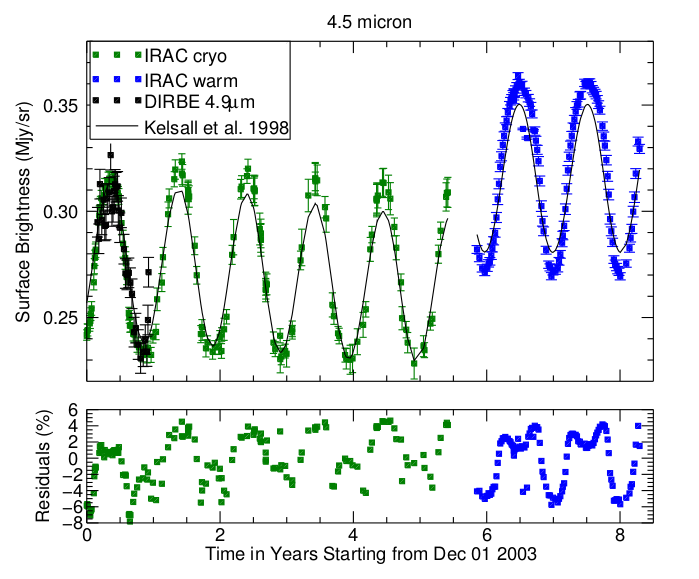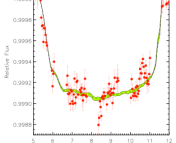- Title: A Spitzer IRAC Measure of the Zodiacal Light
- Authors: Jessica Krick et al.
- First Author’s Institution: Spitzer Science Center, California Institute of Technology
What is the zodiacal light?
The zodiacal light (ZL), a faint glow in the sky that appears close to the Sun along the ecliptic (the Sun’s apparent path through the celestial sphere), is composed of scattered and thermal emission from interplanetary dust particles. The dust itself is believed to come from comets and asteroids, and has a complicated shape: there is a smoothly distributed cloud, three asteroidal debris dust bands, a circumsolar dust ring near 1 AU, plus many more components (Figure 1). The standard ZL model has over 90 free parameters!

Figure 1: A schematic of the zodiacal cloud. The dust is indicated by the purple haze, while the green haze indicates asteroids and the Vs indicate comets.
Why is it important?
Apart from the instrument itself, ZL is the dominant background source for space-based infrared observations. Consequently, it is extremely important to model it accurately in order to subtract out its effect on other science goals. One is the cosmic infrared background, in which the ZL can be anywhere between one and hundreds of times brighter than the signal of interest. Another is the study of intracluster light in galaxy clusters (or any measurement of extended surface brightness, where light is spread out over a patch on the sky), in which the ZL may be significant. Of course, the model itself is of astrophysical interest, and may be compared to extrasolar interplanetary dust models in order to find exoplanets.
In this paper, the authors present new observations of the ZL and suggest additions to the standard model.
Observations
The Infrared Array Camera (IRAC) instrument on the Spitzer Space Telescope observes a field near the north ecliptic pole every few weeks in order to measure the bias and dark current in its arrays. This observation is useful for the ZL since it is free of bright stars and extended galaxies, and looks perpendicularly through the zodiacal cloud.
Spitzer operated cryogenically from 2003 to 2009 with channels at 3.6, 4.5, 5.8, and 8.0 microns. After the cryogen ran out, only the 3.6 and 4.5 micron channels were functional. The background level is assumed to be composed of ZL, the cosmic infrared background, and residual instrumental dark current. The measurement is then just the mean of a gaussian that fits a histogram of all pixel values, where each pixel counts up the number of photons it collected in the integration. Since the other two sources remain constant in time, any variation in the signal is attributed to the ZL.
Results
The data show a sinusoidal variation, which is the signature of the ZL. This is due to the precession of the target field about the north ecliptic pole, the eccentric orbits of the dust particles, and the tilt of the zodiacal cloud relative to Earth’s orbit. As Spitzer moves above and below the dust plane, it sees different column densities (dust integrated along the line of sight) towards the target field. Since IRAC does not use a shutter, it is difficult to determine the absolute instrumental background level. The vertical offset in the plots is therefore ignored and the authors just consider the sinusoidal variation (Figure 2). Data from the Diffuse Infrared Background Experiment (DIRBE) on the Cosmic Background Explorer (COBE) satellite from 1989-1990 were also plotted for comparison, phased in time to match up with IRAC.

Figure 2: Target field surface brightness at 4.5 microns (green points are are from the cryogenic mission, while the blue are from the warm mission). The sinusoidal variation is the signature of the ZL as Spitzer looks through different column densities. Notice the residuals after subtracting out the standard ZL model, indicating a systematic discrepancy.
When compared to the standard ZL model (Kelsall et al.), there are obvious systematic discrepancies: a sinusoidal component and a slight preference for negative residuals, meaning that the model underpredicts the ZL. The authors attribute these discrepancies to several possible causes: they could be caused by an overdensity of dust behind the Earth, in addition to warping in the interplanetary dust cloud. Although small, variations of several percent will be very important for studies of the cosmic infrared background and any physical conclusions that may be drawn from it — so it is clear that generating a new ZL model is important!





Trackbacks/Pingbacks